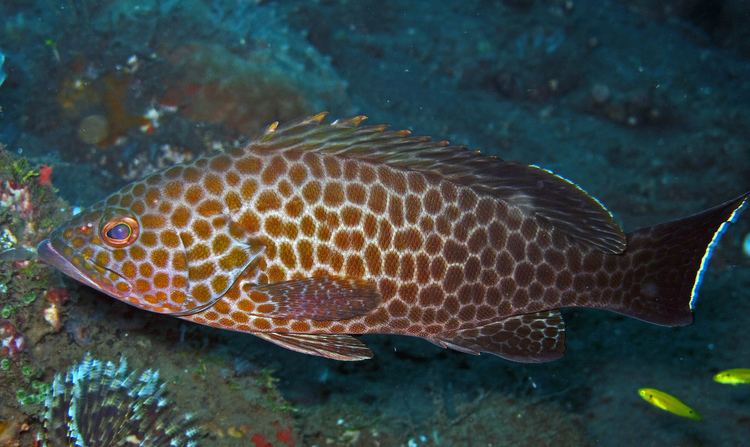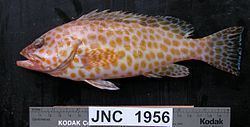Rank Species | Phylum Chordata Higher classification Epinephelus | |
 | ||
Genus EpinephelusBloch, 1793 Similar Grouper, Hong Kong grouper, Banded grouper, Epinephelus, Orange‑spotted grouper | ||
Areolate grouper spearfishing japan
The areolate grouper (Epinephelus areolatus) is a fish of a genus of groupers. It is a marine fish that inhabits coral reefs in the Indo-Pacific region. They are produced through aquaculture and commercially fished. They currently face no threats to their survival.
Contents
- Areolate grouper spearfishing japan
- areolate grouper epinephelus areolatus
- Description
- Distribution
- Reproduction and feeding
- Commercial production
- References

areolate grouper epinephelus areolatus
Description
The areolate grouper is a large fish (up to 47 cm long, 1.4 kg) that lives near coral reefs. Its coloration is whitish to gray with rounded brownish spots; it is particularly identifiable by a narrow, white, straight margin on its truncate tail. It has 11 dorsal spines, 15-17 dorsal soft rays, 3 anal spines and 8 anal soft rays.

According to FishBase, the areolate grouper is known by several other common names in English, including the areolate rock cod, squaretail rock cod, yellow-spotted rock cod, green-spotted rock cod, and flat-tailed cod. Several Middle Eastern and Asian languages have common names for this fish, as well. It is often confused with the brownspotted grouper (Epinephelus chlorostigma) found in the Persian Gulf and several other many-spotted species.
Distribution
The areolate grouper is found in the tropical region ranging from 35°N - 33°S, 29°E - 180°E. They are found in the Indo-Pacific region from the Red Sea and the Persian Gulf to Natal, South Africa and east to Fiji, north to Japan, south to the Arafura Sea and northern Australia. It was recently recorded to have been observed in Tonga, but appears to be absent from areas in the western Indian Ocean.
This grouper is usually found in seagrass beds or on fine sediment bottoms near rocky reefs, dead coral, or alcyonarian corals. in shallow continental shelf waters. Juveniles are common at water depths to 80 m; eggs and early larvae are probably pelagic.
Reproduction and feeding
Like other groupers, the areolate grouper is a sex-changing species; young are female, and some change to male with maturity. Maturity is reached at a fork length of 22 cm, and spawning usually occurs during the months of May, June, October and December.
After hatching, wild grouper larvae eat copepods and other small zooplankton. Areolate grouper feed on fish and benthic (bottom-dwelling) invertebrates, primarily prawns and crabs.
Commercial production
The areolate grouper is one of about 16 species of groupers commonly raised using aquaculture. Floating net cages, the primary culture method, are supported by a floating frame of plastic pipe, wood, or other material, and usually are anchored to the sea floor. This method is simple, has low capital investment, and uses existing bodies of water, so production can be easily increased or decreased. Disadvantages compared to pond culture include vulnerability to external water quality problems and predators. Also, no control over water temperature, which is known to strongly affect growth rates, is possible.
Grouper consistently demands a high market price, so fishing pressure is intense. To alleviate the pressure on wild grouper stocks, many nations have promoted aquaculture in the hopes of producing a more sustainable grouper yield. Hong Kong is the primary producer of areolate grouper raised by aquaculture, and about 155 metric tons were produced in 2004. Full-cycle culture of most grouper species, including the areolate grouper, is not yet possible, although several important advances have been made in recent years. For this reason, about two-thirds of all grouper culture, including culture of E. areolatus , involves the capture of wild grouper eggs which are then grown out in aquaculture. This is called capture-based aquaculture (CBA). The wild eggs are gathered by a variety of artisianal methods, and because success is not predictable, the production varies as well.
Commercial fishing for areolate grouper done with long lines and hand lines. While its popularity for food has led to some species being threatened, currently no threat to the survival of E. areolatus exists. The table at right shows the amount of areolate grouper produced by farming between 1992 and 2004 and the amount produced by capture in Saudi Arabia (Indian Ocean) between 1996 and 2004, according to the Food and Agriculture Organization of the United Nations
